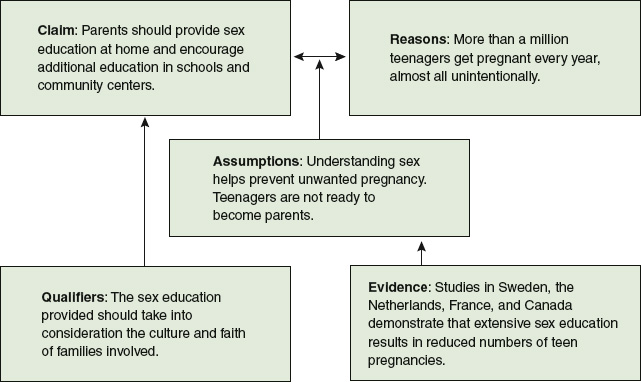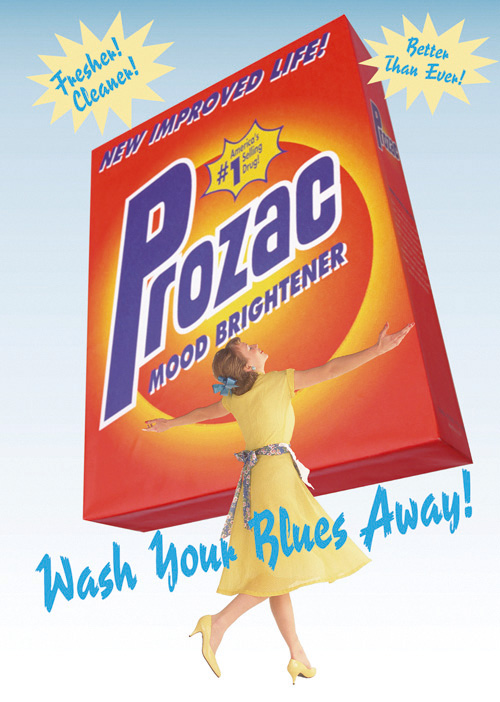13dAnalyze the elements of argument.
According to philosopher Stephen Toulmin’s framework for analyzing arguments, most arguments contain common features: a claim or claims, reasons for the claim, assumptions (whether stated or unstated) that underlie the argument, evidence (facts, authoritative opinion, examples, statistics, and so on), and qualifiers that limit the claim in some way. In the following discussion, we will examine each of these elements in more detail. The figure on p. 148 shows how these elements might be applied to an argument about sex education.
ELEMENTS OF A SAMPLE TOULMIN ARGUMENT

Claims
Claims (arguable statements) are statements of fact, opinion, or belief that form the backbone of arguments. Claims worthy of arguing are those that are debatable: to say “Ten degrees Fahrenheit is cold” is a claim, but it is probably not debatable—unless you are describing northern Alaska, where ten degrees might seem relatively balmy.
Reasons
A claim is only as good as the reasons explaining why the claim should be accepted. As you analyze claims, look for reasons drawn from facts, from authorities, from personal experience, and from examples. Test each reason by asking how directly it supports the claim, how timely it is, and what counter-reasons you could offer to question it.
Assumptions
Putting a claim and reasons together often results in what Aristotle called an enthymeme, an argument that rests on an assumption the writer expects the audience to hold. These assumptions (which Toulmin calls warrants) that connect claim and reasons are often the hardest to detect in an argument, partly because they are often unstated, sometimes masking a weak link. As a result, it’s especially important to identify the assumptions in arguments you are analyzing. Once the assumption is identified, you can test it against evidence and your own experience before accepting it.
Evidence
As a critical reader, you must evaluate each piece of evidence (what Toulmin calls backing) the writer offers. Analyze how the evidence relates to the claim, whether it is appropriate and timely, and whether it comes from a credible source.
Qualifiers
Qualifiers offer a way of limiting or narrowing a claim so that it is as precise as possible. Words or phrases that signal a qualification include few, often, in these circumstances, rarely, some, typically, and so on. Claims having no qualifiers can sometimes lead to overgeneralizations. For example, the statement Grading damages learning is less precise than Grading can damage learning in some circumstances. Look carefully for qualifiers in the arguments you analyze, since they will affect the strength and reach of the claim.
Analyzing elements of a visual argument
Visual arguments, too, can be analyzed using Toulmin’s methods. Look at the accompanying advertising parody: it contains few words, yet it makes a subtle argument. A group of students discussed this advertisement, observing that the image intends to evoke a 1960s-era detergent commercial. They came up with several possible claims that the ad might be making.
| Possible Claim | Pharmaceutical companies want to convince consumers that taking drugs to cure depression is no more serious than trying a new detergent. |
| Possible Claim | Consumers should beware of drug advertisements that make hard-to-prove claims aimed at getting customers to ask for a prescription. |
| Possible Claim | Buying products will not lead to greater happiness. |

All of these claims can be supported by the ad. If you were to choose the first claim, for instance, you might word a reason like this: This parody of a Prozac ad looks like a detergent commercial from the 1960s, but the product is a chemical that promises to “wash your blues away.” With some research into the actual dangers and benefits of antidepressants, you might find evidence that ads for such drugs sometimes minimize their downside and exaggerate their promise. You might also note that the ad’s design takes viewers back to a decades-old scene of domestic happiness, suggesting that Prozac could return its users to some mythically perfect time in the past—and you would be well on your way to an analysis of this visual argument.